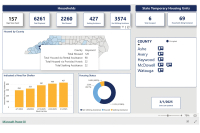Brought on in crisis, extra ambulance shows it’s mettle
When Haywood Regional Medical Center suspended its care of Medicare and Medicaid patients last February, Jim Pressley realized there was no time to waste.
The announcement, kept secret by the hospital CEO until the last minute, was effective immediately. The result: hundreds of patients flooding across county lines to the hospitals in either Asheville or Sylva. As the Emergency Services director, Pressley’s job suddenly got a lot harder.
Within 24 hours, Pressley had an extra ambulance added to the county’s fleet.
Ten months later, Pressley says the county needs to keep running that extra ambulance.
Although the hospital has been fully functioning since July, more patients continue to be transported out of the county than previously — mostly to Asheville. Ambulance trips out of the county are up nearly 50 percent this year, Pressley said. Out-of-county transports now account for 26 percent of all ambulance trips.
Aside from the increase in out-of-county transports, EMS has simply seen a rise in calls. Last year, ambulance drivers handled around 8,000 calls. This year it will be nearly 10,000, Pressley said.
That increase, coupled with the continued out-of-county transports, makes the case for making the extra ambulance a permanent part of the county’s fleet, Pressley said. He made a pitch along those lines to the Haywood County commissioners last week.
The county’s budget currently only has enough money to operate the extra ambulance through the end of the year. Pressley asked the commissioners to allocate the money to keep it in operation.
The extra ambulance has been staffed to date with existing medics working overtime. Pressley wants to hire six full-time medics instead. Pressley said the current medics have been worn out on overtime trying to staff the extra ambulance over the past 10 months.
“Quite honestly there are days when it is a struggle to cover that truck with the people we have,” Pressley told commissioners.
To hire the six new full-time medics, it will cost the county $60,000 a year over and above what it is currently paying in overtime. The total cost to staff the extra ambulance is about $400,000 a year, according to Finance Director Julie Davis. The county makes roughly 60 percent of that back through fees paid by patients, their insurance or Medicare.
Since ambulance trips are up, so are payments from patients. In fact, payments are up so much it’s enough to cover the cost of the extra medics without dipping into county coffers for the current fiscal year.
Commissioner Mark Swanger said the extra ambulance sounds like a necessity.
“Given our demographics in Haywood County, we are older than the national average and we aren’t getting any younger,” Swanger said. “I think it is important to keep up with that changing demographics or it will require large sums of money to catch up.”
Pressley said even if the hospital crisis hadn’t occurred, he would have asked the commissioners to fund an additional ambulance this year, citing the rising number of 911 calls and the growing need for transport to high-level trauma care offered at Mission.
Commissioners agreed to make the extra ambulance permanent and will vote for the necessary budget allocation at their first meeting in January.
Straight shot
One reason for the growing out-of-county transports is a new strategy to send trauma patients in need of high-level care directly to Mission Hospital in Asheville. For example, Mission does heart catheterizations, a life saving treatment for heart attack patients, while hospitals of Haywood’s size generally don’t.
“Now when someone has a heart attack we are diagnosing those on the scene and taking a lot of these patients straight on to Mission, not even stopping at the Haywood emergency department and just going straight to the cath lab,” Pressley said.
There’s a similar protocol for stroke patients.
Ambulances often transport patients with broken backs, hips or legs to Mission, too, not because the care couldn’t be handled locally but because Haywood continues to be plagued by an orthopedic shortage. The shortage means there isn’t always an orthopedist on call, so patients even with routine problems could be sent on to Mission sometimes.
“I know HRMC is not alone as a community hospital in their struggle to maintain orthopedic coverage,” Pressley said.
Down to a science
The county runs a fleet of six ambulances, including the extra one slated to become permanent. Each ambulance is assigned a general territory, and sticks to that territory until a call comes in. There’s two in Waynesville, one in Canton, one in Clyde, one in Maggie and one in Bethel.
Before the addition of a sixth ambulance to the fleet, there wasn’t one stationed in Bethel. When a call came in from Bethel, Cruso or Lake Logan, an ambulance roving the Canton or Waynesville territories raced there as fast as they could. With the addition, ambulance crews have shaved five minutes off the average response time to an area that once had the slowest response.
“We’ve made great strides in decreasing our response time to that area,” Pressley said.
But having that sixth ambulance in Bethel helps response times everywhere else as well. When an ambulance assigned to Waynesville was dispatched to Bethel, that left Waynesville down an ambulance. Throughout the day, the roving ambulances are continually shuffled between territories in a pre-emptive strategy to predict where the next calls will come in, a technique called a “move-up.” Pressley said there were 3,000 of these “move-ups” logged this year. “We are constantly moving trucks around to try to anticipate where the next call is going to be with the end goal of trying minimize our response time and maximize the amount of coverage we can provide to the rest of Haywood County,” Pressley said.
Commissioner Curtis Skeeter said he doesn’t want to lose improvements made on response time.
“If we don’t fund this, we are going to backslide,” Curtis said.
Commissioner Kevin Ensley said the county clearly can’t keep using overtime medics to staff the ambulance.
“I got family that lives in that area and I think it is important not to have a fatigued paramedic,” Ensley said.





